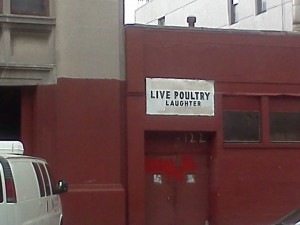I live on a funny little street corner in Brooklyn.
If you walk in one direction, there is Greenpoint—filled with Polish bakeries and businesses, and perhaps one of my favorite shop signs in all of New York City.

In another direction is Williamsburg—filled with coffee shops, vegan restaurants, bicycles and hipsters in flannel shirts and cut off shorts. In Williamsburg, fancy and expensive high-rise condos overlooking the polluted beauty of the East River (and I suppose the Manhattan skyline) have become as ubiquitous and indicative of the neighborhood as the classic, flat colorful houses or vegan laundromats.
 It is not a joke!
It is not a joke!
In the opposite direction are abandoned factories, some transformed into artists’ lofts, some into crack dens and some probably a lovely combination thereof. To the south, is Grand Street—as you walk south, the predominant language changes from English to Spanish, the businesses are Puerto Rican, the bakeries are Dominican and there is music from every corner—whether it’s the radio outside the shop or cars driving down the avenue with all of the windows down.
On my block itself, there is a motorcycle training school (it comes in handy), several little houses with flat wood paneling on the outside and our bodega. Our building itself has a little bit of graffiti on it and a bicycle out front. It has red trim on the windows, and I can see the Palestinian flag I have in my window from the street. It’s home.
There—amidst the flat wood paneled houses, no more than three stories high, the bodega and the super convenient motorcycle training school and few warehouses that characterize my block—is a chic, glassy condominium.
It is completely empty.
Williamsburg has seen record rates of condominiums popping up over the past five years—and Bushwick (and apparently my little area that happens to be nestled in between) seems to be quickly following suit as the most quickly gentrifying neighborhood. But for now, these condos of the future venture capitalists that find a quaint charm in my local motorcycle training school are empty—while homeless men and women sleep outside the subways and many across New York City face foreclosure evictions from their homes. On a less extreme scale, the types of businesses that the condo-inhabiting corporate types and of course, the notorious young white hipster crowd bring are often out of the price range and immediate needs of those who already live in the neighborhood.
It is easy to feel queasy about this issue of gentrification. It’s multi-faceted—and there are many valid and sometimes contradictory arguments. I know that by all definitions I’m a technically gentrifier in my neighborhood—but as Nona Willis Aronowitz points out in a recent piece
for The Atlantic, the current economic climate leaves few other options. I live in a little room in a building that has quite obviously been there for decades. I try to make my presence small, support the local businesses and avoid the newer, more expensive establishments that are most aggressively transforming the neighborhood’s traditional economic cycle. But what about these fancy condominiums? What about these tall, glassy buildings with elevators that are sold by relators as “East Williamsburg” and boast views of Manhattan from a carefully groomed roof? What about the buildings that were there before and had to be torn down to make room for the newer building? Where are the people that were forced out, who—like me–used to look up at their windows from the street and call that street corner home?
In a recent interview on GRITtv with Laura Flanders, Julia Abumada Grob—co-creator of the (wonderful) web series East Willy B—a show exploring the Latino perspective of the complications of gentrification in Bushwick—presented the idea of productive gentrification: how do you harness the positive effects of gentrification while still preserving the character—and in habitants—of the neighborhood?
What do you think? What is your relationship to your neighborhood? Do you think that if wielded properly, there is a less aggressive form of gentrification can be a positive force that revives a neighborhood, allowing both the families who have lived there for decades and more recent inhabitants to coexist? What is it like for all of you non-New Yorkers in your respective cities?